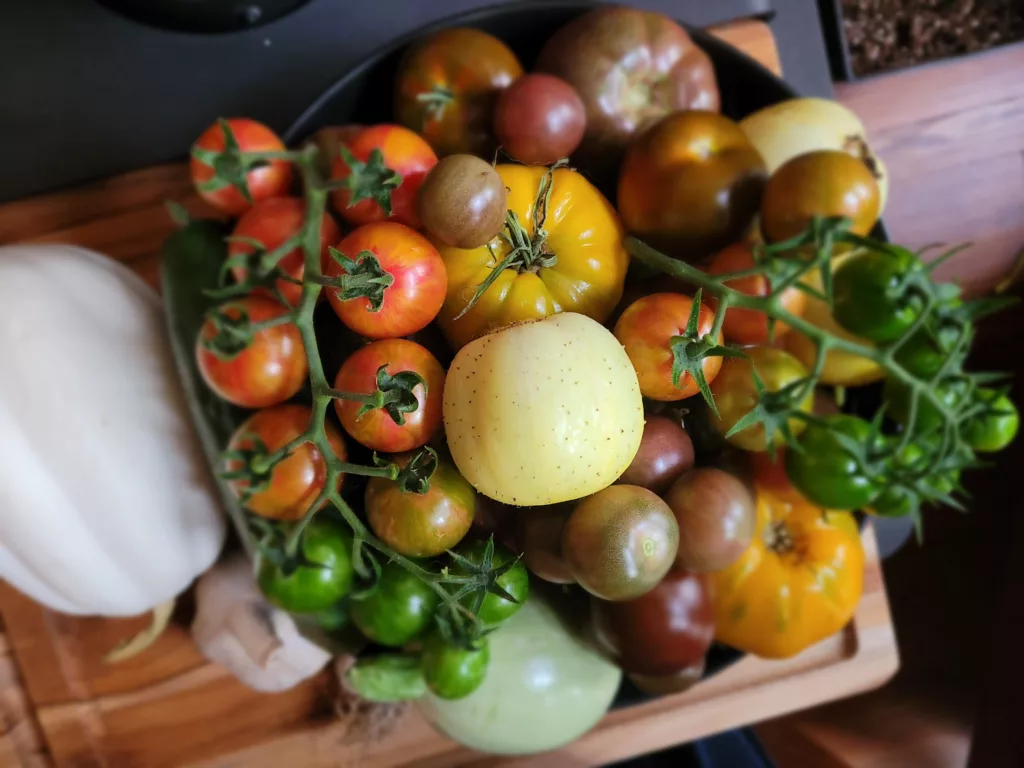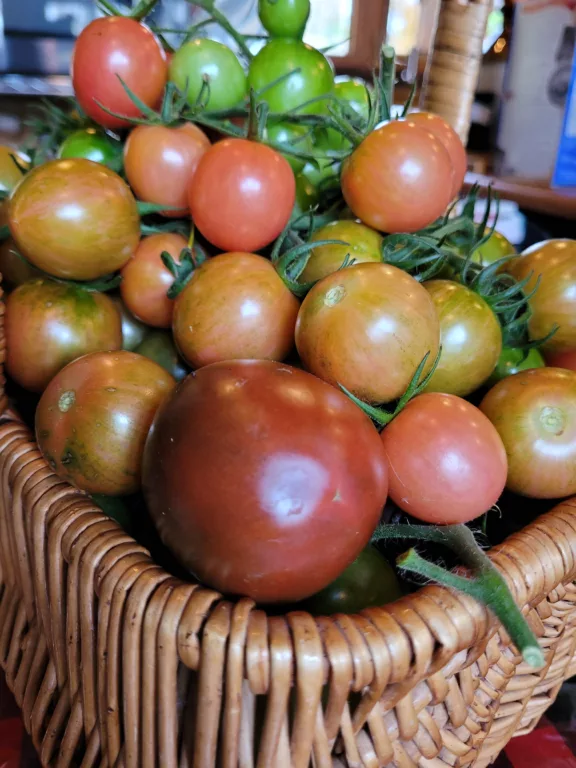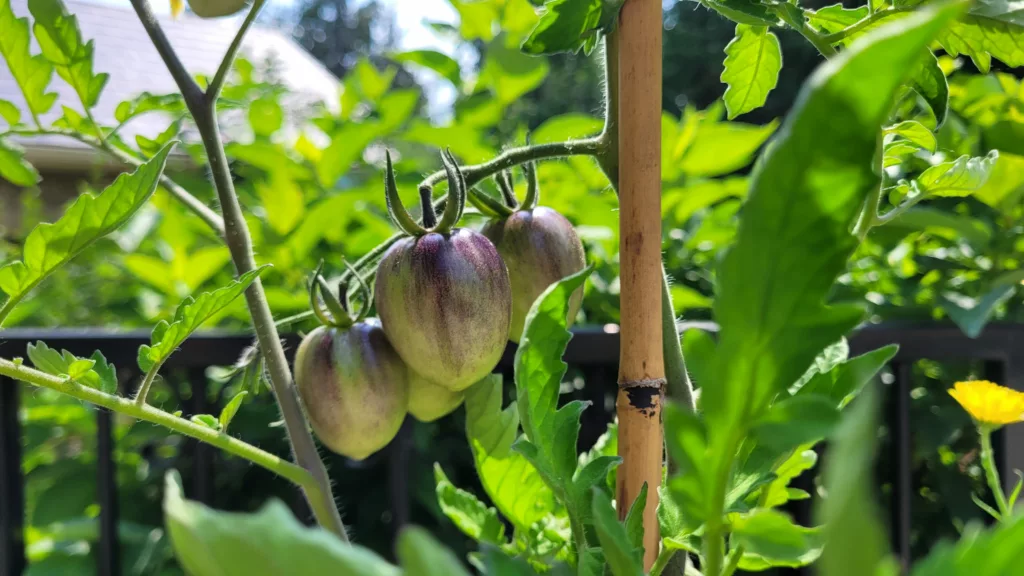This post may contain affiliate links. If you use these links to buy something we may earn a commission. Thanks.
We successfully grew several varieties of tomatoes in our first garden which only got a maximum of 4, maybe 5, hours of direct sun per day, and the rest of the day was bright to moderate shade.
If you also have less than 6-8 hours of sun per day but want fresh tomatoes, you’ll be wondering if tomatoes can grow in shade and what types. The good news is that many have, and many more can.
A tomato expected to fruit in 50-60 days of full sun (6-8 hours per day) will take 100-120 days in shade (3-5 hours of sun per day). The labeled growing period assumes full sun, so with half the sun time per day plus double the days, you’ll still get tomatoes when planted in shade.

All tomatoes can grow vegetation (leaves and vines) in the shade, but only certain varieties can produce good fruit with less than ideal hours of sun. All tomatoes prefer 6-8 hours of direct sun at a minimum to produce prolifically.
You’ll find your plants to be ‘leggier’ than normal with less than 8 hours of direct sun. The fruit will take longer to set and ripen, but with optimal water, nutrients, and pruning you’ll still get fresh tasty tomatoes.
When talking about ‘shade’ for tomatoes we mean 3-5 hours of sun per day and bright or moderate light the rest of the day.
Seed packets will display the range of days till maturity, and this is what you’ll look for when wishing for tomatoes in a shady garden.
Most tomatoes need 90-120 days of full sun to fruit and those won’t produce with less than 6 hours of sun per day.
But many varieties require half the growing time (50-60 days) and will be your best choice. If you have double the time to offer (100-120 days) then you’ll be able to get fruit from these types.
Although this post includes a list with the tomatoes I’ve personally grown in shade and several other varieties that are known to have a short growing period, you can still find other varieties that work for you. Stick to the simple rule of a short maturity period (50-60 days).
Related: Calculate How Many Tomato Plants Per Person Accurately
And some more good news, before you begin scrolling, is you can grow more than just cherry tomatoes in shade!
Roma tomatoes grow in shade because they take only 75 days until maturity. If you can offer at least 150 days with 3-5 hours of sun per day, you can grow Roma tomatoes in shade.
To determine how many days you can offer your tomatoes, view the ‘Conclusion‘ section below for a detailed example.
All seeds can be bought from small shops on Etsy, some of them at your local store, and many from other online sellers such as SeedsNow.
Black cherry

These are the first tomatoes I ever grew. And I grew them on that shady balcony that got no more than 5 hours of sun per day, and probably only 4 a lot of the time.
Black cherry tomatoes need 150 days in the season to fruit in the shade. Their known ‘days to maturity’ is 75.
These are dark red, and delicious-tasting cherry tomatoes. One of the most popular varieties grown.
Spoon tomatoes

Spoon tomatoes are very prolific and I don’t recommend growing more than one plant! They become very tedious to harvest should you decide to grow 15 plants, like I did.
I was prepared to make fermented whole spoon tomatoes but, they are indeterminate and go bad very quickly once ripened, so unless you get a whole jars full worth of them at the same time, you can’t do much other than eat them as they come.
Spoon tomatoes have gorgeous foliage and are suitable for growing in shade. They have tiny fruits which means they require less energy to get started and have a 65-75 day maturity.
Roma

If you have a shady garden but want fresh tomatoes, then perhaps you want more than just cherry tomatoes. I wondered, as well, if roma tomatoes could grow in shade.
Roma tomatoes grow fruit in partial shade as they are very prolific producers with a short maturity period. This popular variety needs 75-80 days to mature. In shade, you’ll need to provide Roma tomato plants with 150-160 days to get good fruit.
So the good new is, you aren’t stuck with cherry tomatoes only. You can grow grape, plum, slicing and beefsteak types of tomatoes!
Dancing with Smurf

Among the first tomatoes I’ve grown, I grew these in shade, dancing with smurf gave us plenty! They will need 120 days of shade as they have a 60 day expected maturity.
Siberia

Siberian tomatoes are determinate and have a short 50 days to maturity. They have been purposefully adapted to move their butts quickly for colder growing climates with shorter growing periods.
Not only are they quick to grow and fruit, but can do so in cooler temperatures, which shade offers.
If you can offer 100 days of partial shade, you should get ripe fruit.
Black Strawberry

Black strawberry tomatoes are incredibly sweet, in our experience.
They have a ’60-day’ maturity timeline and will grow in shade with a minimum of 140 days outside.
We currently grow them in full sun, but they are the very first tomatoes to have fruit this large! None of our other tomatoes have fruit this far along.
So this signals to me that they would do well in shade.
Orange hat

Orange hat tomatoes are a dwarf variety that you can grow indoors or on patio. Anyone with little sun to offer could grow these.
Plant them in a 6 inch pot and give it 50-80 days of shade and you should have some fruit.
These are determinate plants so you get what you get when they mature!
Give them at least 100 days in a spot with less than 6 hours of sun.
Green Zebra
Green zebra tomatoes are medium sized cherry tomatoes. They have a 75 day maturity period.
Give at least 120 days in partial shade conditions to ripen fruit. Baker Creek also offers apricot zebra tomatoes with a 65 day maturity period. I imagine they would also fruit in shade.

San Marzano
San marzano is a popular heirloom paste tomato for sauce-making.
In 75-85 days of ideal conditions, san marzano will fruit continuously until plants are killed by frost (indeterminate).
Give this variety at least 130 days in partial shade to ripen your fruit. Fruit can also ripen off the vine, so be sure to collect all green tomatoes before frost, as with any tomato!
Black krim

Black krim tomatoes are a popular big beefstake tomato. they are indeterminate and take an average of 80 days to mature.
Give at least 140 days in partial shade for ripened fruit. Be sure to water these evenly particularly when fruiting as these heavy fruits are prone to splitting.
Split tomatoes are still tasty but will go bad fast (and attract fruit flies) if not consumed quickly.
Conclusion
As previously stated, other varieties of tomatoes can be grown in shade.
Others have had success with growing:
- Carmello (indeterminate slicing tomato)
- Cherokee purple (indeterminate beefsteak)
- Paul Robeson (indeterminate beefsteak)
- Golden sweet (indeterminate grape)
- Early Wonder (determinate slicing)
- Juliet hybrid (indeterminate grape)
- Isis candy cherry (indeterminate cherry)
- Mama leone (indeterminate plum)
- Sun gold (indeterminate cherry)
Simply determine how many days you have in your growing season, divide that by 2, and grow tomatoes with the appropriate ‘days to maturity.’
Determine growing season days:
I can see how many days I can offer tomatoes by referring to my spreadsheet journal.
On April 12th, I sow tomatoes indoors. In 9 weeks (63 days) I transplant them outdoors. They have 13 weeks (91 days) to grow before frost kills the plants.
(A tomato expected to mature in 70 ‘days’ will need 140 days in a shady spot (with 3-5 hours of sunlight) to fruit.)
13 weeks plus 9 weeks means I can offer 154 days of growth to any tomato plant. If I have full sun, I can grow any type of tomato and get fruit. If I only have shade (3-5 hours of sun) then I can grow any tomato that requires 77 days or less to mature.
If I want to grow a tomato with 80-90 days until maturity, I’ll need to start them indoors 2-3 weeks earlier and give them bigger pots, as needed, until I can transplant them outside.
This isn’t an exact science, but it is best to count the ‘days to maturity’ from after you transplant outdoors.
So in my case, if I can offer 5 hours of sun per day, then I can grow most varieties on this list. If I can offer 3 hours of sun per day, then I should choose varieties with no more than 60-70 days to maturity as they’ll only have 91 days after transplanting.
Starting indoors earlier is only a good idea if you can provide proper care with a bigger pot size, good soil, fertilizer, and plenty of light.
Best tomatoes for shade are high-yielding, mature in short periods, and
Up Next: Calculate How Many Tomato Plants Per Person Accurately
Recent Posts
There’s no shortage of full-sun ground covers for zone 4 climates! Each plant in this list can withstand the frigid temperatures and also enjoy the hot sun in summer. Full sun means that a plant...
There's no shortage of full sun ground covers, not even in zone 3! Zone 3 climates offer hot but short-lived summers and very cold winters. So each plant in this list can withstand the frigid...

